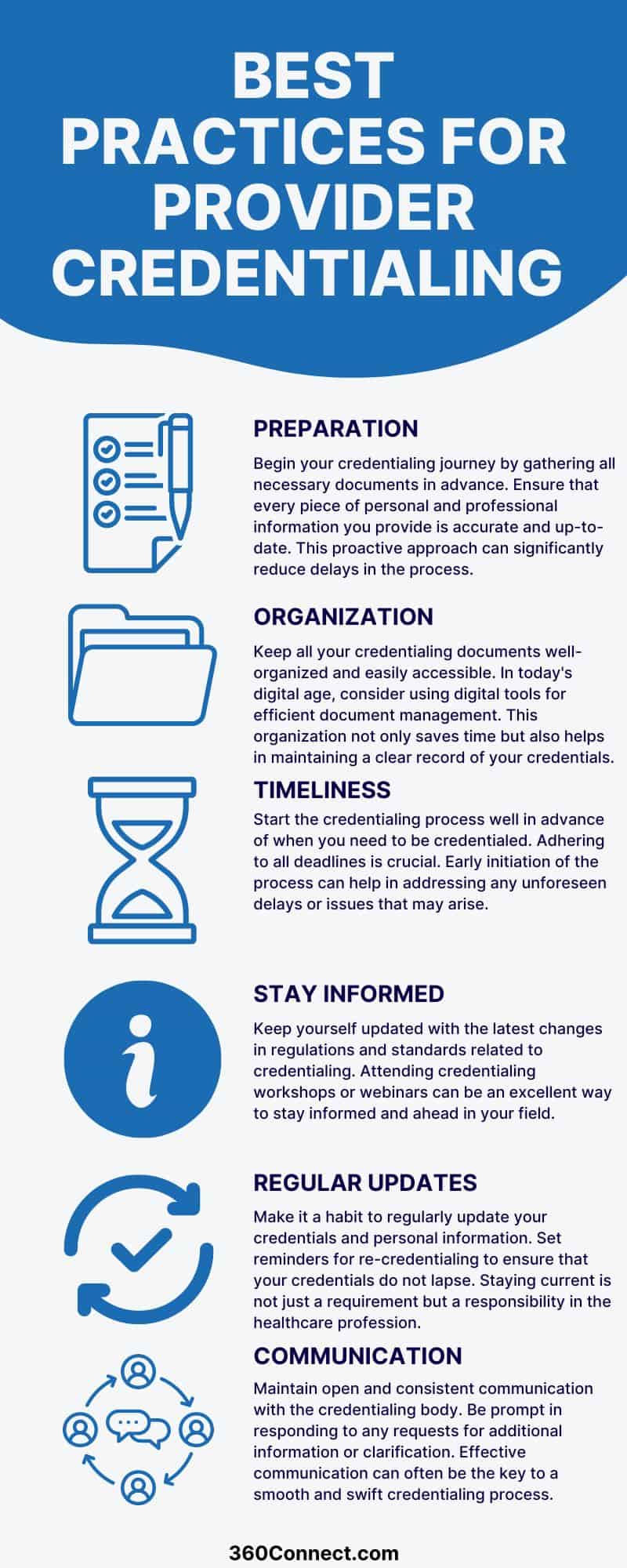Provider credentialing is not a one-time process, rather it is ongoing as providers will need to be re-credentialed around every 3 years. It is necessary and a vital process for the provider, the health organization, and patients to receive the most vital care. Provider credentialing is a thorough verification of a provider’s qualifications, including their education, training, experience, and licensure.
Who Does It?
The hospital or healthcare facility is the final body that approves the verification of a provider’s credentials. A hospital will likely employ a credentialing specialist or outsource to a credentialing service to perform primary source verification. However, once they conduct the primary source verification, they will then submit this information to also be credentialed by insurance for medical billing and other medical bodies.
Who Sets the Standards?
The Centers for Medicare & Medicaid Services (CMS) and the Joint Commission on Accreditation of Healthcare Organizations, require credentialing and from accredited sources. If these standards are not followed then those healthcare facilities are not eligible for reimbursement from Medicare or Medicaid. Common entities that hospitals follow for standards include:
- Joint Commission on Accreditation of Healthcare Organizations
- National Committee for Quality Assurance (NCQA)
- The Accreditation Association for Ambulatory Healthcare (AAAHC)
- Det Norske Veritas (DNV)
- Utilization Review Accreditation Commission (URAC)
Key Components of Provider Credentialing
Credentialing is critical for maintaining high standards of care, ensuring patient safety, and meeting regulatory and legal obligations. Provider credentialing entails the following:
- Education and Training Verification: This phase guarantees that the healthcare provider has the required educational and training background. It entails validating records from medical school, residency, fellowships, and any subsequent training.
- Licensure Verification: During this part, healthstate whereproviders will verify that providers have valid licenses to practice medicine in the state they are located.
- Work History and Experience: A thorough evaluation of the provider’s work history is performed to ensure they have relevant experience in their area.
- Background Checks: This includes looking into the provider’s criminal record, malpractice claims, and disciplinary measures. This may be a background check of 5 to 10 years or a longer background check.
- Peer References: You’ll need to have peer references that vouch for your credibility and competence. These peers will need to be other healthcare professionals.
- Specialty Certification: Additional accreditation may be necessary for particular specialties, which is also validated throughout the credentialing process.
Smartsheet offers a sample of the information contained in an application that you can view here.
The Credentialing Process
While every healthcare provider has a slightly different credentialing process, there are some general steps that are going to follow. Each credentialing process is meticulously done and requires time. It can often take several months to complete the full process. Here is the general process:
Data Gathering
This process requires that the applicant gather the materials for submission. An applicant will need to provide copies and evidence of all the required material.
Application Submission
Now, a healthcare provider begins to submit a thorough application. Personal information, educational background, employment history, references, and any other pertinent information are all included in this application.
Verification of Credentials
Once the application is submitted, the credentialing body (which could be a hospital, insurance company, or independent credentialing organization) begins the verification procedure. This entails contacting institutions, licensing boards, and other relevant agencies to ensure the authenticity of the information provided.
Committee Review
A credentialing committee reviews the application after all credentials have been validated. This committee is typically made up of healthcare specialists and board members who evaluate the provider’s qualifications and abilities to deliver care.
Approval and Enrollment
If the application is approved by the committee, the provider is credentialed. This approval may also entail enrollment in specific healthcare networks or insurance panels, allowing them to serve a larger patient population.
Ongoing Monitoring and Re-credentialing
Regular re-credentialing of providers is required often around every three years. This ensures that they keep their qualifications and follow changing healthcare standards.
The duration of the credentialing process can vary based on a number of factors, including the depth of the verification process, the responsiveness of the entities providing verification, and the specific needs of the credentialing body. Delays can arise if there are inconsistencies in the information provided or if further information is necessary.
A Medical Credentialing Buyer’s Guide
Learn MoreWhy Provider Credentialing is Essential
Provider credentialing is a vital area of our healthcare system. It tackles many different problems with thorough solutions. Here’s why provider credentialing is so essential.
Ensuring Quality and Safety in Healthcare
Credentialing’s primary purpose is to ensure that healthcare providers satisfy the essential standards of care. Credentialing helps to maintain a high level of care and patient safety by confirming practitioners’ skills and competencies.
Legal and Regulatory Compliance
Provider credentialing is required for compliance with various legal and regulatory obligations. Healthcare institutions and providers must follow state and federal requirements, and credentialing assures that they do so. This compliance is critical for avoiding legal obligations, but also for retaining certification.
Building Trust with Patients and Insurance Companies
Credentialing fosters patient trust by assuring them that they are receiving care from qualified personnel. It also builds confidence with insurance companies and other healthcare organizations, who must depend on qualified individuals to treat patients and not have lawsuits on their hands.
Facilitating Provider Mobility and Career Advancement
Credentialing can also let healthcare providers move around across jurisdictions and healthcare systems. It also helps with job growth because many businesses look for qualified experts when hiring.
Challenges in Provider Credentialing
While provider credentialing is a routine process for many, that doesn’t mean that it doesn’t come without its problems. Here are some common problems providers and specialists may run into.
Complexity and Time-Consuming Process
Credentialing can’t just be completed in a day. The credentialing process is frequently a multi-step and time-consuming task. It requires the collection and verification of a wide range of papers and information. This complication might cause delays, which can be inconvenient for physicians eager to begin practicing or for healthcare facilities in need of their services. In general, the process can take around 3-4 months.
Varying Standards and Requirements
The standards and regulations for credentialing vary greatly between jurisdictions, healthcare systems, and insurance organizations. These changes across states can lead to misunderstanding and extra labor for providers who work in diverse settings or cross state lines.
Data Management and Privacy Concerns
The vast amount of sensitive personal and professional information involved in credentialing poses data privacy and security concerns. It is a big issue to ensure the security and integrity of this information.
Credentialing Errors and Inaccuracies
Credentialing errors, whether caused by wrong information or misunderstanding, can have serious implications. They can cause delays, credentialing denials, and even legal concerns.
Keeping Up with Continuous Changes
Healthcare legislation and standards are always changing. Maintaining compliance with credentialing processes and keeping up with these developments is an ongoing problem for credentialing bodies and providers alike.

Need Provider Credentialing Services
Do you need provider credentialing services for you or your healthcare facility? Want a trusted partner that can help sift through this process, optimize your processes, and save you time? Don’t worry though, 360Connect has your back! We help customers find high-quality suppliers that understand their needs. Just fill out our 1–2-minute form and we’ll reach out to you to verify your information and needs. From there, sit back and relax as up to 5 suppliers reach out to you with quotes. This process is 100% free and simple to do!

